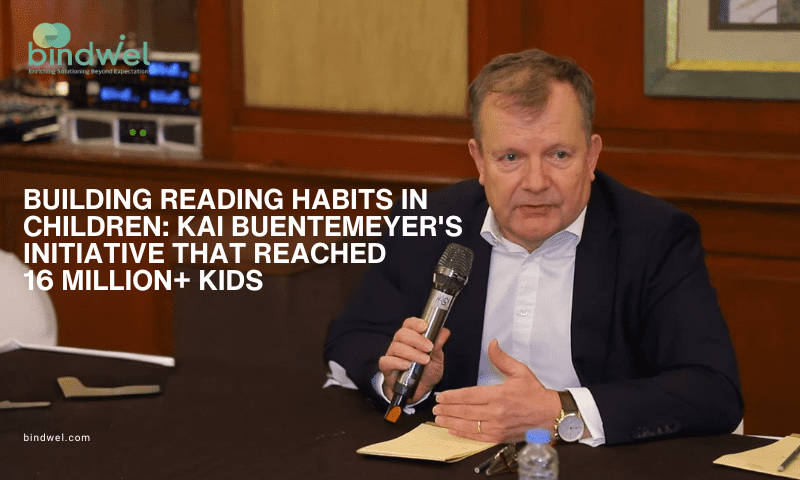In today’s digital era, children are surrounded by countless distractions—video games, social media, and streaming platforms. It’s no surprise that reading is often pushed aside. However, building reading habits in children is more important than ever. With the right strategies, we can ensure that the love for books is passed down to the next generation.
So, how do we nurture reading habits in a world dominated by technology? Let’s explore why reading matters, the challenges it faces, and how to turn children into lifelong readers, drawing on insights and real-world examples.
Why Building Reading Habits in Children Matters
Building reading habits in children isn’t just about improving academic performance; it’s about fostering creativity, imagination, and critical thinking. Unlike skills we might be born with or genetically programmed for, like walking or breathing, reading is an entirely learned skill. As Kai Buentemeyer, a prominent expert in the Engineering and Branded Goods Packaging sector and Director at Bindwel Technologies, points out, “No one is born a reader.” Yet, in our hyper-complex modern societies, reading has become an absolutely essential ability for navigating the world.
Reading shapes how children process information, think critically, and communicate effectively, opening doors to exploration and fostering cognitive, social, and emotional growth.
The Digital Distraction Problem & The Threat of Video
In a world dominated by digital entertainment, building reading habits in children has become a challenge. Games, social media, and videos capture attention instantly, while reading demands sustained focus. Technology isn’t the enemy if used for reading, but as Kai notes, a specific medium is a powerful competitor.
Why? Our brains process video easily, almost effortlessly, tapping into primal responses that feel comfortable and rewarding. Kai pinpoints the core issue: “The problem is there’s a medium on the smartphone that is the big killer, and that is VIDEO.” This ease is because, as his analysis suggests, with video, the brain doesn’t need to work as hard to create meaning compared to reading text. This inherent ease of video consumption makes it a potent competitor. The potential consequence is severe, as Kai warns directly: “That’s why video is so dangerous. It will drive out reading, and we will lose the capability that is essential for survival in a complex society.”
Putting Principles into Practice: A German Success Story
To combat declining reading habits, Kai Buentemeyer collaborated with the German “Foundation for Reading” (Stiftung Lesen). They introduced a program based on a US model where pediatricians gift durable “playbooks” to 4-5 year olds during mandatory checkups, advising parents on reading. Utilizing Germany’s healthcare system for universal reach, Kai raised €1 million to fund the initial launch. This impactful initiative, running since around 2008 and now government-funded, has reached approximately one million children annually, touching the lives of an estimated 16 million children to date. This demonstrates the power of early, accessible interventions in fostering a love for reading.
How to Build Reading Habits in Children (Proven Strategies)
Kai’s initiative highlights key principles. Here are proven strategies for parents and educators for building reading habits in children:
1. Introduce Books Early
As the German program shows, early exposure is critical. Studies confirm lasting literacy benefits. As Kai advocates through his work, introducing children to books early is highly beneficial. Make even the first books tactile and durable, ensuring positive initial interactions.
2. Make Books Accessible
Ensure books are readily available everywhere – home, schools, public spaces, even doctors’ offices! Accessibility was key to the German program’s success and reach. Having a diverse collection encourages children to explore different genres and topics, fostering curiosity.
3. Leverage Technology Wisely
While video is a challenge, technology can support reading. E-books, interactive reading apps, and audiobooks provide children with multiple ways to engage with stories and text, making reading fun and interactive for different types of learners.
4. Lead by Example
Children are more likely to read books if they see the adults around them reading. Make reading a visible part of your daily routine. Whether it’s a physical book, a magazine, or an online article, modeling a love for reading is highly effective.
5. Create a Reading Routine
Consistency is key when it comes to forming habits. Set aside a specific time each day dedicated to reading books—whether it’s before bed, after school, or during quiet time. A consistent routine helps children prioritize reading.
Creating a Future Full of Readers
The journey to building reading habits in children is both rewarding and essential for their future. Reading books fosters intellectual growth, empathy, and creativity. By encouraging it early and consistently, we lay the foundation for a brighter future. The success of initiatives like the one Kai championed underscores the importance of making books exciting, accessible, and part of daily life.
By nurturing a reading culture at home, in schools, and within the community, we can ensure that reading remains a cherished and beneficial habit that shapes future generations.
Continuing the Mission: Bindwel’s Contribution
This commitment to fostering reading continues in various ways. For instance, Bindwel actively runs the “Gift a Book to a Child” initiative. This program has already distributed over 100,000 books, furthering the mission of putting books directly into children’s hands and promoting accessibility.
Take Action and Cultivate a Reading Culture
Want to learn more about how to nurture a love for reading in children? Follow us on social media for more insights, resources, and tips on building reading habits in children and fostering a lifelong love of books!
Stay ahead of the curve in the world of bookbinding!
Follow Bindwel on Facebook, LinkedIn, Twitter, Instagram and YouTube for the latest industry updates, innovative solutions, and expert tips to optimize your production.





